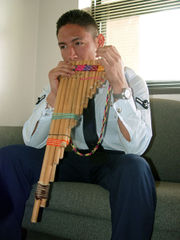 The
pan flute (also known as panpipes, syrinx,
or quills) is an ancient
musical instrument based on the principle of the stopped
pipe, consisting usually of ten or more pipes of gradually
increasing length. The
syrinx (Greek
συριγξ) has long been popular as a folk instrument, and is
considered the ancestor of both the
pipe organ and the
harmonica, or mouth organ. The pan flute is named for
its association with the rustic Greek god
Pan.
The
pan flute (also known as panpipes, syrinx,
or quills) is an ancient
musical instrument based on the principle of the stopped
pipe, consisting usually of ten or more pipes of gradually
increasing length. The
syrinx (Greek
συριγξ) has long been popular as a folk instrument, and is
considered the ancestor of both the
pipe organ and the
harmonica, or mouth organ. The pan flute is named for
its association with the rustic Greek god
Pan.
 Playing the zampoña, an
Inca instrument and type of pan pipes.
Playing the zampoña, an
Inca instrument and type of pan pipes.
The pipes comprising it are stopped at one end, so that the sound waves have to travel twice the length of the pipes, giving out a note nearly an octave lower than that produced by an open pipe of equal length. In the traditional South American style, pipes are fine-tuned to correct pitch by placing small pebbles or dry corn kernels into the bottom of the pipes. Contemporary makers of curved Romanian-style panpipes use wax (commonly beeswax) to tune new instruments. Special tools are used to place or remove the wax. Corks and rubber stoppers are also used, and are easier to quickly tune pipes.
The pan flute is played by blowing horizontally across the open end against the sharp inner edge of the pipes. This creates the regular series of pulses which generate the sound waves within the tubes. Each pipe is tuned to a note, called the fundamental. By overblowing, that is, increasing the pressure of breath and tension of lips, harmonics (notes whose frequencies are multiples of the fundamental) may also be produced. The Romanian panflute has the pipes arranged in a curved array, enabling the player to easily reach all the notes by simply swiveling their head. These instruments can also play all the sharps and flats, with a special technique of both tilting the pipes and jaw movement. An advanced player can play any scale and in any key. There are two styles of vibrato possible, hand vibrato and breath vibrato. In hand vibrato, the player applies a gentle motion to one end of the panflute (usually the high end) in much the same way as a violinist would wiggle their finger stopping the string to produce vibrato. Breath (or diaphragm) vibrato is the same technique used by players of the flute and other woodwinds.
The plural of syrinx is syringes, from which the modern word syringe is derived. (Pan pipes is both singular and plural.) Other names for the instrument include the Medieval fistula panis.
The pan flute was most recently popularised by the Romanian musician Gheorghe Zamfir, who toured extensively and recorded many albums of pan flute music, and by several other artists who began recording at the same time. They are also very popular in Peruvian traditional groups and other Andean music.
This simple instrument was used in some songs by The Beatles, Simon and Garfunkel, Bee Gees, Agustín Lara, Luis Miguel and Céline Dion.
Types of pan flutes
Paixiao (China)
Syrinx
Pan flute players
- Gheorghe Zamfir
External links
- Video: How to Play Panflute by Brad White
- Visit Pan-Flute.Com's All About Panflutes by Brad White
- A Worldwide History of the Panflute by Douglas Bishop
- Free Panflute Lessons by Douglas Bishop
- The Hall of Panflutists by Douglas Bishop
Categories: Woodwind instruments




 216.73.216.190
216.73.216.190 User Stats:
User Stats:
 Today: 0
Today: 0 Yesterday: 0
Yesterday: 0 This Month: 0
This Month: 0 This Year: 0
This Year: 0 Total Users: 117
Total Users: 117 New Members:
New Members:
 216.73.xxx.xxx
216.73.xxx.xxx
 Server Time:
Server Time: